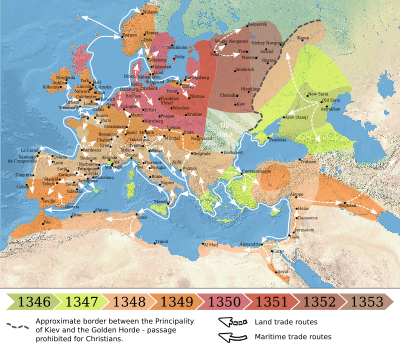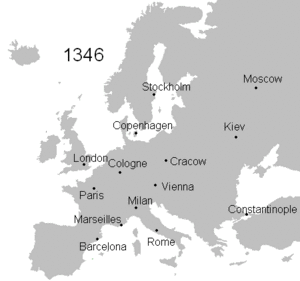Black Death facts for kids

|
|
| Disease | Bubonic plague |
|---|---|
| Location | Eurasia and North Africa |
| Date | 1346–1353 |
|
Deaths
|
25,000,000 - 50,000,000 (estimated) |
The Black Death was a terrible pandemic that swept across Europe and Asia in the 14th century. This deadly disease was at its worst between the years 1347 and 1351. It caused a huge number of deaths and changed society forever.
Many historians believe the Black Death was caused by the bubonic plague. This disease was carried by fleas that lived on rats. These rats often traveled on ships, especially those from Genoa. This allowed the plague to spread quickly to port cities around the Mediterranean Sea. Some also think traders on the Silk Road might have brought infected fleas to Europe.
The plague first reached Europe in 1347 through Genoese traders at the port city of Kaffa in the Crimea. From Italy, it spread across Europe. By June 1348, it had hit France, Spain, Portugal, and England. It then moved east and north into Germany, Scotland, and Scandinavia between 1348 and 1350. It even reached northwestern Russia by 1351. Some isolated areas, like parts of the Basque Country and the Netherlands, were less affected.
When an infected flea bit a person, it injected tiny bacteria into the wound. This caused the person to get sick. The disease caused painful swellings, called buboes, in the groin, under the arms, and behind the ears. These swellings often turned a black and purple color, which is why the disease was called 'The Black Death'. People suffered greatly, and many died a horrible death. Symptoms usually appeared 3 to 7 days after a flea bite.
Not all historians agree that it was only the bubonic plague. Some suggest that other diseases, like anthrax or a viral hemorrhagic fever, might have also been part of the pandemic.
The Black Death returned many times to Europe and the Mediterranean region from the 14th to the 17th centuries. It was present almost every year somewhere in Europe between 1346 and 1671. Later outbreaks were severe but showed the plague slowly disappearing from most of Europe and North Africa.
Contents
What Caused the Black Death?
One main cause of the Black Death was a change in climate in Asia. This made rodents, like marmots, leave their dry grasslands and move into areas where more people lived. These rodents carried fleas infected with the plague bacteria, called Yersinia pestis. This bacteria is still found today in fleas on rodents in places like Central Asia and the western United States.
The Y. pestis bacteria was discovered by Alexandre Yersin in 1894 during a plague outbreak in Hong Kong. He also found the bacteria in rodents, suggesting rats were important in spreading it. Later, in 1898, Paul-Louis Simond figured out how the bacteria usually spreads. Fleas that bite an infected animal get their stomachs blocked by the bacteria. This makes the fleas very hungry and causes them to throw up the bacteria when they try to feed on a new host, like a human. This then infects the new host.
The spread of bubonic plague also depended on two groups of rodents. One group was resistant to the disease and kept it going. The other group was not resistant and died off. When this second group died, the fleas moved to other hosts, including people, causing a human epidemic.
How Doctors Understood the Disease
In the 14th century, medical knowledge was very different from today. Doctors believed in Hippocrates's theory of humorism. This idea said that the human body had different fluids, or "humors." If these fluids were balanced, a person was healthy. If they were out of balance, the person got sick. Many people also thought diseases were a punishment from God.
The humorism theory could not explain why diseases spread from person to person. Most people thought that infection was caused by miasma, which meant "bad air." They believed this bad air could come from the earth itself and cause illness. Some suggested remedies included opening only north-facing windows and not working too hard.
In 1348, the King of France, Philip VI of France, asked the doctors at the University of Paris about the cause of the Black Death. They decided it was caused by a bad alignment of the planets Jupiter, Saturn, and Mars on March 20, 1345. Since this was based on astrology, many people believed it.
Because no one truly understood what caused the plague, doctors had no real treatments that worked. Often, doctors would simply tell their patients to go to Confession to have their sins forgiven before they died. The pandemic eventually made doctors rethink how the human body worked. About 200 years later, Girolamo Fracastoro discovered that diseases spread through infection.
Lack of Cleanliness
People did not understand how important hygiene was until the 19th century, when the germ theory of disease was developed. Before that, streets in cities were often very dirty. Live animals and human waste were common, which helped diseases spread easily.
By the early 14th century, many European cities were very unclean. Some streets were even named after human waste. Pigs, cattle, chickens, and other farm animals roamed freely in cities like London and Paris.
Homeowners were supposed to keep the area in front of their houses clean, including removing animal waste. However, most city dwellers were not careful about this.
In many parts of medieval Europe, rules about cleanliness were simple. Homeowners were often just required to shout, "Look out below!" three times before emptying a full chamber pot into the street.
Early Christians sometimes saw bathing as a temptation. For example, St. Benedict said, "To those who are well, and especially to the young, bathing shall seldom be permitted." St. Agnes is said to have died without ever bathing.
The Huge Impact of the Black Death
There are no exact numbers for how many people died, as the death toll varied greatly from place to place. Some estimates suggest that the Black Death may have killed between 75 million and 200 million people across Europe and Asia.
The Black Death also changed Europe's social structure in a big way. It weakened the power of the Roman Catholic Church. It also led to widespread persecution of minorities like Jews, Muslims, foreigners, beggars, and lepers. Because daily survival was so uncertain, people often chose to live for the moment. This is shown in a famous book called The Decameron (1353) by Giovanni Boccaccio.
The first outbreak in Europe in the 14th century was called the "Great Mortality" by people living at the time. With later outbreaks, it became known as the 'Black Death'.
Interesting Facts About the Black Death
- The term "Black Death" was not used in English to describe this plague pandemic until the 1750s. It became popular from Swedish and Danish writings in the 15th and early 16th centuries. Before that, most European languages called the pandemic something like "Great Death."
- The Black Death was the second major natural disaster to hit Europe during the Late Middle Ages. The first was the Great Famine of 1315–1317.
- Research from 2017 suggests that plague might have first infected humans in Europe and Asia much earlier, during the Late Neolithic and Early Bronze Age.
- It is thought that the Black Plague, like other outbreaks throughout history, affected the poorest people and those already in poor health more than wealthier citizens.
- The word "quarantine" comes from this period. The idea of isolating people to stop disease spread is older. In 1377, the city-state of Ragusa (modern Dubrovnik, Croatia) started a thirty-day isolation period for new arrivals from plague-affected areas. This period was later extended to forty days and called "quarantino," from the Italian word for "forty."
Related pages
Images for kids
-
Yersinia pestis (200 × magnification), the bacterium which causes plague
-
Pieter Bruegel's The Triumph of Death reflects the social upheaval and terror that followed plague, which devastated medieval Europe.
-
A plague doctor and his typical apparel during the 17th Century Outbreak.
-
Contemporaneous painting of Marseille during the Great Plague in 1720
See also
 In Spanish: Peste negra para niños
In Spanish: Peste negra para niños











